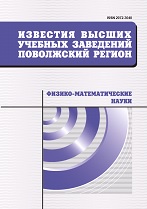|
|
University proceedings. Volga region. Physical and mathematical sciences, 2014, Issue 4, Pages 164–175
(Mi ivpnz328)
|
 |
|
 |
Physics
Experimental study of charging-discharging currents in supercapacitors
A. S. Ambrozevich, R. T. Sibatov, V. V. Uchaikin, E. V. Morozova
Ulyanovsk State University, Ulyanovsk
Abstract:
Background. Supercapacitors are electric energy storage devices, which find application in various systems: wind turbines, photovoltaic systems, biomedical sensors and hybrid cars. These electrochemical devices are capacitors with an organic or inorganic electrolyte, where electrical double layers at the interface between electrodes and the electrolyte serve as plates. To increase the area of the electrical double layer electrodes porous or foamed metals are used. Also, the electrodes based on activated carbon nanotubes, graphene oxide and other materials have been proposed recently. The small thickness of the electrical double layer, comparable to the size of the solvent molecules (5-10 nm), as well as the large surface area of the electrodes provide large capacitance, short charging periods, in comparison with batteries, and high specific density of accumulated energy. There is a need for refinement of models and diagnostic methods for supercapacitors. Materials and methods. The kinetics of charging-discharging currents in the Panasonic two-layer supercapacitor samples with nominal capacitance of 0.22 F was studied in a wide range of time periods from 0.1 to 10$^4$ sec. In these samples, an organic electrolyte and electrodes on the basis of the activated carbon of the fine fraction type were used. Relaxation of current was analyzed in the framework of a linear response model. Voltage dependencies of capacitance and internal resistance were calculated via the measured curves of cyclic charging by direct current. The influence of temperature, external voltage, and charging prehistory on the supercapacitor characteristics was also studied. Results. Relaxation in the studied supercapacitor samples is non-Debye. At short time periods, relaxation of current is close to the stretched exponential law $i(t) \infty exp(-t^\beta / \tau^\beta)$ with $\beta$ parameter values in the range from 0.5 to 0.7. For self-discharging, $\beta$=0,5 is typical. For long time period, the asymptoric behavior of current is exponential $i(t) \infty t^{-\alpha}$, with $\alpha$ values in the range from 0.8 to 1.2. Increase in temperature leads to a decrease in internal resistance, which affects the change in the index of the power law and the tendency to pass-through conduction, as well as reducing the scale parameter of the stretched exponential law. The dependencies of capacitance and internal resistance of the supercapacitor on voltage were found via the measured curves of cyclic charging by direct current. Conclusions. Unlike ordinary capacitors, the response of the supercapacitor samples (at operating voltages of 3-5 V) to variation of charging regimes is not consistent with the linear response model. The observed voltage dependencies of capacitance and internal resistance can be explained by the inclusion of additional percolation paths and isolated pores in the relaxation process with increasing voltage. The supercapacitor properties deteriorate due to the prolonged charging-discharging cycles, capacitance is reduced and internal resistance is increased. The voltage dependencies of capacitance for the new samples A and B are similar, but $r(U)$ is sufficiently different. This difference can be attributed to greater sensitivity of effective resistance (rather than capacitance) to random realizations of the porous electrodes.
Keywords:
supercapacitor, charging-discharging current kinetics, current relaxation, cyclic charging curves.
Citation:
A. S. Ambrozevich, R. T. Sibatov, V. V. Uchaikin, E. V. Morozova, “Experimental study of charging-discharging currents in supercapacitors”, University proceedings. Volga region. Physical and mathematical sciences, 2014, no. 4, 164–175
Linking options:
https://www.mathnet.ru/eng/ivpnz328 https://www.mathnet.ru/eng/ivpnz/y2014/i4/p164
|

|




 Contact us:
Contact us: Terms of Use
Terms of Use
 Registration to the website
Registration to the website Logotypes
Logotypes








 Citation in format
Citation in format 